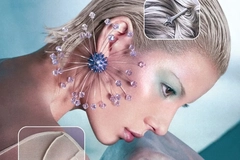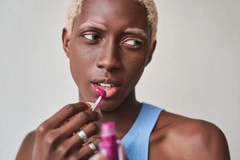BASF expands on epigenetics, skin microbiome, hair and skincare trends at IFSCC

19 Oct 2021 --- BASF is addressing advances in epigenetics, skin microbiome research, extraction, the revival of Traditional Chinese medicine, as well as studies on acne-prone skin and hair loss at IFSCC. “Our R&D projects help cosmetic manufacturers answer the needs of the personal care industry and consumers,” Valérie André, scientific scouting and communication expert at BASF Beauty Care Solutions, tells PersonalCareInsights.
“They allow for increased personalization thanks to epigenetic studies, natural ingredients with traditional health benefits that are sourced locally and developed and produced with high-quality standard, or by giving a deep insight into the microbiota composition to improve skin conditions.”
“The IFSCC is a relevant scientific event for the cosmetic and personal care industry where developments are shared. Scientists can present in preview their latest research findings on sustainable beauty, skincare, haircare, sun protection or new advanced methods to evaluate skin physiological mechanisms to further select performing active ingredients,” adds André.
The presentation of BASF’s scientific findings will take place during the 26th International Federation of Societies of Cosmetic Chemists (IFSCC) Conference held between October 18-28.
The conference will be held as a virtual-only event due to the ongoing COVID-19 pandemic. BASF will share its findings during poster and podium sessions.
Skin microbiome
The skin microbiome is essential for skin health and has been the subject of many studies in the cosmetics field in recent years, according to the company.
During the conference, BASF will give insight into the differences in skin microbiota composition between young and aged skin, with a specific focus on wrinkles. Traditional Chinese Medicine (TCM) is experiencing a revival for its use in cosmetics.
Traditional Chinese Medicine (TCM) is experiencing a revival for its use in cosmetics.
The company adds that having identified microbiome species that are more prevalent on younger persons’ skin, the next step will be to exemplify their potential function and impact on the skin to develop solutions that ultimately help preserve a youthful appearance.
While much focus is currently being given to individual bioactives that can affect the microbial composition of the skin, the second study explores the effects of galenics contained in a cosmetic formulation, such as emollients, emulsifiers and polymers.
This was brought to identify ingredients and design formulations that do not disrupt the complex microbial community found on healthy skin.
In light of the increasing importance of the skin microbiome, PersonalCareInsights reported on Dermala’s NPD that targets the gut-skin axis and improves acne and skin blemishes.
Meanwhile, Innova Market Insights’ data revealed that the demand for microbiome personal care products is rising, with products that feature a prebiotic or probiotic claim having experienced annual growth of 73% in the past five years (Global, CAGR 2016-2020).
Traditional Chinese medicine
Traditional Chinese Medicine (TCM) is experiencing a revival for its use in cosmetics. In BASF’s poster session, researchers will share results on their study of three TCM plants from the Yunnan province of China and their extracts’ efficacy for skin health and beauty.
The BASF team was able to yield highly titrated extracts containing either iridoids, flavonoids, or a polysaccharide and evaluate their biological potential.
The results encourage the use of those TCM extracts to respond to three significant cosmetic market demands: moisturization (Dendrobium sp. stems), anti-aging (Pyracantha sp. fruits) and sensitive skin (Gentiana sp. roots).
Epigenetic regulation
BASF scientists will also share findings on reverse histone modification induced by UVA damage.
Epigenetic regulation has been increasingly considered to play an essential role in photoaging. Indications of aging correlate with epigenetic alterations that regulate transcription. BASF will also give insight into how Heparan sulfate proteoglycans play an essential role in regulating hair shaft growth.
BASF will also give insight into how Heparan sulfate proteoglycans play an essential role in regulating hair shaft growth.
The research team clarified the impact of specific acetylation among post-translational modifications of histones and its effect on the expression of dermal proteins involved in skin elasticity. The study results provided the basis for selecting products that could help support healthier skin post photo exposure.
Targeting acne-prone skin
Two further sessions led by BASF will examine various approaches to developing effective ingredients for acne-prone skin, focusing on the impact of Cutibacterium acnes.
In one of the studies, BASF experts explored the potential of the commensal strain Staphylococcus epidermidis to protect the skin against this pathogen. To evaluate bacterial interactions, the research team developed bacterial and 3D microbiotic skin models.
The insights gained helped the team develop active ingredients inspired by the ecology of the skin microbiota to support the natural mechanisms of skin defense.
The second study builds on the finding that different phylogenic groups (phylotype I to III) are present within the C. acnes population and that C. acnes can also be characterized by their difference in the release of virulence factors.
BASF scientists defined appropriate methods to characterize and efficiently modulate these virulence factors. Improving signs of acne-prone skin led to BASF having a greater understanding of their efficacy and evaluating ingredients on various strains of C. acnes.
Hair follicle structures
BASF will also give insight into how heparan sulfate proteoglycans (HSPGs) play an essential role in regulating hair shaft growth.
Together with research partners from the University of Reims Champagne-Ardenne, BASF scientists will present a new approach to assess hair histology and HSPG distribution changes in hair follicles at different phases of the hair growth cycle.
The infrared spectral imaging method allows simultaneous revealing of the location, signatures and, in a semi-quantitative manner, the content of proteins, proteoglycans, glycosaminoglycans, and sulfated glycosaminoglycans in hair follicles.
The company adds that from a cosmetological point of view, it thus represents a promising technique for studying the causes of hair loss.
By Nicole Kerr












